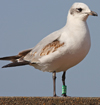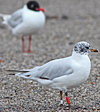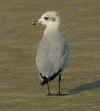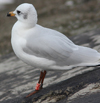 Mediterranean Gull (L. melanocephalus)
Mediterranean Gull (L. melanocephalus)
(last update: June 11, 2012)

Mediterranean Gulls, July 30 2001, Le Portel, NW France. By the end of July, already 100's of Mediterranean Gulls are present, including juveniles, summer plumage adults and winter plumage adults. They feed at the beach and flocks of a few hundreds may rest at the rocks, right beneath the village.
Mediterranean Gulls used to breed in a restricted area in the countries north of the Mediterranean, the Black Sea and east to Dagestan. When Karel Voous wrote his Atlas of European Birds (1965) the distribution of this species was so limited that he suggested that it might be heading for extinction. Since the late 1980’s this species has spread north and the world population has increased spectacularly. It now breeds regularly in Belgium, the Netherlands, England, Ireland, Hungary and Poland. After the breeding season, Mediterranean Gull disperse westwards and can be found south along the Moroccan Atlantic coast and along the coasts of the Mediterranean. Large flocks congregate at the beaches of Boulogne-sur-Mer (NW France) from August to October, later moving southwards. In early spring tens of thousands can be seen at Cambrils on the north-eastern coast of Spain.
Most images on this page were taken at Le Portel / Boulogne-sur-Mer, France (50.42. 20 N,01.34.03 E). Le Portel is known to be one of the best sites to see Mediterranean Gulls with numbers exceeding 3.000 individuals during some autumns. As can be seen in the images, many individuals are colour ringed or metal ringed, and come from Mediterranean Gull populations from all over Europe. Colour-ringing Mediterranean Gulls started in The Netherlands in 1989 with only a handful of birds. Twenty years on thousands of birds have been colour-ringed and at the start of 2008 there are tens of projects all over Europe.
Mediterranean Gull is a medium sized gull, with an intense black head in adult summer and rather pale grey upper-parts. Easy clues for identification and ageing in Mediterranean Gull are the median coverts and outer primaries. Most of the description below follows P.J. Grant: "Gulls, a guide to identification".
First half of the year (January - June) the primaries are juvenile in 2CY birds, obvious also in a closed wing (image above).
Still, 3rd generation primaries are distict white, but such flight feathers are only seen after another complete summer moult in autumn 3cy birds and older, full adults (image below).Pictures: J.M. Sauvage.
|
2CY MEDITERRANEAN GULL
The spring moult in Mediterranean Gull is a partial moult, from February to April and includes body and head resulting in a so-called "first summer" plumage. Most noticeable is the replacement of head feathers: the head becomes much darker with some birds developing a full hood, but many only have some black flecking. The remiges and rectrices remain juvenile and by April have become bleached and abraded. Some individuals include inner wing-coverts in this partial moult, but the juvenile outer wing-coverts are retained and therefore very abraded. The colour of bare parts become more adult-like, with the bill-base turning paler red-orange. Most birds have extensive black on the bill tip, most prominent on the lower mandible. This is the most variable plumage in Med Gull since the appearance of 2cy birds depends on the combination of the extent of the post-juvenile moult, and bleaching and wear in the winter quarters.
From May to September, the first complete moult takes place, into so-called "second winter" plumage. The head pattern resembles the pattern in first winter birds, with a blackish mask behind the eye. The mantle, scapulars, tertials and all wing-coverts are replaced with plain pearl-grey feathers. The secondaries are as in adult birds, pale grey with a white tip. The second generation primaries are much paler than the first juvenile primaries, but still not nearly all-white as in adults. After finishing this complete moult a 2cy Mediterranean Gull in autumn has a diagnostic wing-tip pattern with a variable amount of black on P5-P10. P5 has only a small black sub-terminal spot, becoming gradually larger on the outer primaries as the black patch "eats up" the white along the edge of the outer-web, most prominent on P9-P10. In some birds, the outer greater primary coverts and rarely the alula coverts may show dark markings as well. The bill is orangey-red with a dark sub-terminal band. The legs are dull red or more obvious orangey-red. As with 2cy birds there is individual variation in this age group but it is less pronounced and mostly involves the amount of black in the outer primaries and the colour of the bill.
3CY MEDITERRANEAN GULL
Next moult in Mediterranean Gull is again a partial moult, from February to April and includes body and head, bringing birds in so-called "second summer" plumage. Most noticeable is the replacement of head feathers: the head becomes darker with birds developing a full hood, some still show limited flecking. The white tips of the primaries become slightly worn. The colour of bare parts become adult-like, with the orbital ring and bill turning coral red, the bill often with a thin black bill-band. The legs are scarlet red. The iris turns deep reddish-brown.
From late summer to September, a complete moult takes place, into so-called "third winter" or "adult winter" plumage. The head pattern resembles the pattern in first winter birds, with blackish mask behind the eye. The mantle, scapulars, tertials and all the wing-coverts are replaced for plain pearl-grey feathers. The secondaries are completely white. The adult primaries are shiny pearly-grey, flashing white at a distance. There is a black line along the outer-web of P10 (and sometimes on P9 as well). Secondaries, under-wing and tail all completely white. The bare part coloration in adult plumage: Iris brown, orbital ring red or orangey-red, the bill red or orangey-red with a black bill-band and a yellowish tip and the legs dull reddish or dark.
The next moult in Mediterranean Gull is again a partial moult, from February to April and includes body and head, bringing birds in so-called "second summer" plumage. Most noticeable is the replacement of head feathers: the head becomes darker with most birds developing a full hood, some still show limited flecking. The white tips of the primaries become slightly worn. The colour of bare parts become adult-like, with the orbital ring and bill turning coral red, the bill often with a black bill-band of varying width. The legs are scarlet red. The iris turns deep reddish-brown. As with 2CY birds there is individual variation in this age group but it is less pronounced and mostly involves the amount of black in the outer primaries and the fullness of the hood.
From June to September, a complete moult takes place, into so-called "third winter" or "adult winter" plumage. The head pattern resembles the pattern in first winter birds, with blackish mask behind the eye. The mantle, scapulars, tertials and all the wing-coverts are replaced for plain pearl-grey feathers. The secondaries are completely white. The adult primaries are shiny pearly-grey, flashing white at a distance. There is a black line along the outer-web of P10 (and sometimes on P9 as well). Secondaries, under-wing and tail all completely white. The bare part coloration in adult plumage: Iris brown, orbital ring red or orangey-red, the bill red or orangey-red with a black bill-band and a yellowish tip and the legs dull reddish or dark. There is some variation in 3cy and 4cy wing-tip patterns.
 Mediterranean Gull 2cy L37 January 03 2002, Boulogne-sur-Mer, France (50.42N,1.34E).
Mediterranean Gull 2cy L37 January 03 2002, Boulogne-sur-Mer, France (50.42N,1.34E). Mediterranean Gull 2cy HE68 January & December 2010, Le Portel / Boulogne-sur-Mer, NW France. Picture: Jean-Michel Sauvage.
Mediterranean Gull 2cy HE68 January & December 2010, Le Portel / Boulogne-sur-Mer, NW France. Picture: Jean-Michel Sauvage. Mediterranean Gull 2cy W99 January 11 2010, Le Portel / Boulogne-sur-Mer, NW France. Picture: Jean-Michel Sauvage.
Mediterranean Gull 2cy W99 January 11 2010, Le Portel / Boulogne-sur-Mer, NW France. Picture: Jean-Michel Sauvage. Mediterranean Gulls 2cy 3JW2 & 14W February 2003, Boulogne/Mer, France (50.42N,1.34E).
Mediterranean Gulls 2cy 3JW2 & 14W February 2003, Boulogne/Mer, France (50.42N,1.34E). Mediterranean Gull 2cy 3LM2 February 06 2003, Boulogne/Mer, France (50.42N,1.34E).
Mediterranean Gull 2cy 3LM2 February 06 2003, Boulogne/Mer, France (50.42N,1.34E). Mediterranean Gull 2cy 3LU4 February 07 2003, Boulogne-sur-Mer, France (50.42N,1.34E).
Mediterranean Gull 2cy 3LU4 February 07 2003, Boulogne-sur-Mer, France (50.42N,1.34E). Mediterranean Gull 2cy 8S7 March 06 2010, Le Portel / Boulogne-sur-Mer, NW France. Picture: Jean-Michel Sauvage.
Mediterranean Gull 2cy 8S7 March 06 2010, Le Portel / Boulogne-sur-Mer, NW France. Picture: Jean-Michel Sauvage. Mediterranean Gull 2cy K49 April 20 2002, Boulogne-sur-Mer, France (50.42N,1.34E).
Mediterranean Gull 2cy K49 April 20 2002, Boulogne-sur-Mer, France (50.42N,1.34E). Mediterranean Gull 2cy HL61 June 29 2009, Le Portel / Boulogne-sur-Mer, NW France. Picture: Jean-Michel Sauvage.
Mediterranean Gull 2cy HL61 June 29 2009, Le Portel / Boulogne-sur-Mer, NW France. Picture: Jean-Michel Sauvage. Mediterranean Gull 2cy ZTY1 July 20 2014, Le Portel, NW France. Picture: Jean-Michel Sauvage.
Mediterranean Gull 2cy ZTY1 July 20 2014, Le Portel, NW France. Picture: Jean-Michel Sauvage. Mediterranean Gull 1-3cy HRF1 2008-2010, Le Portel / Boulogne-sur-Mer, NW France. Picture: Jean-Michel Sauvage.
Mediterranean Gull 1-3cy HRF1 2008-2010, Le Portel / Boulogne-sur-Mer, NW France. Picture: Jean-Michel Sauvage. Mediterranean Gull 2cy & 4cy 2S2 July 2010 & July 2012, Le Portel, France.
Mediterranean Gull 2cy & 4cy 2S2 July 2010 & July 2012, Le Portel, France. Mediterranean Gull 2cy, July 27 2001, Le Portel, France (50.42N,1.34E).
Mediterranean Gull 2cy, July 27 2001, Le Portel, France (50.42N,1.34E). Mediterranean Gull 2cy 63P August 09 2003, Le Portel, France.
Mediterranean Gull 2cy 63P August 09 2003, Le Portel, France. Mediterranean Gull 2cy 48W, August 09 2003, Le Portel, France.
Mediterranean Gull 2cy 48W, August 09 2003, Le Portel, France. Mediterranean Gull 2cy, August 09 2003, Le Portel, France.
Mediterranean Gull 2cy, August 09 2003, Le Portel, France. Mediterranean Gull 2cy 3JE7 August 09 2003, Le Portel, France.
Mediterranean Gull 2cy 3JE7 August 09 2003, Le Portel, France. Mediterranean Gull 2cy, August 09 2003, Le Portel, France.
Mediterranean Gull 2cy, August 09 2003, Le Portel, France. Mediterranean Gull 2cy 3NW5 August 09 2003, Le Portel, France.
Mediterranean Gull 2cy 3NW5 August 09 2003, Le Portel, France. Mediterranean Gull 2cy R12V November 19 2010, Le Portel / Boulogne-sur-Mer, NW France. Picture: Jean-Michel Sauvage.
Mediterranean Gull 2cy R12V November 19 2010, Le Portel / Boulogne-sur-Mer, NW France. Picture: Jean-Michel Sauvage. Mediterranean Gull 2cy HFN2 November 30 2009, Le Portel / Boulogne-sur-Mer, NW France. Picture: Jean-Michel Sauvage.
Mediterranean Gull 2cy HFN2 November 30 2009, Le Portel / Boulogne-sur-Mer, NW France. Picture: Jean-Michel Sauvage. Mediterranean Gull 2cy HL67 November 30 2009, Le Portel / Boulogne-sur-Mer, NW France. Picture: Jean-Michel Sauvage.
Mediterranean Gull 2cy HL67 November 30 2009, Le Portel / Boulogne-sur-Mer, NW France. Picture: Jean-Michel Sauvage. Mediterranean Gull 2cy HNK3 November 30 2009, Le Portel / Boulogne-sur-Mer, NW France. Picture: Jean-Michel Sauvage.
Mediterranean Gull 2cy HNK3 November 30 2009, Le Portel / Boulogne-sur-Mer, NW France. Picture: Jean-Michel Sauvage. Mediterranean Gull 2cy HE68 January & December 2010, Le Portel / Boulogne-sur-Mer, NW France. Picture: Jean-Michel Sauvage.
Mediterranean Gull 2cy HE68 January & December 2010, Le Portel / Boulogne-sur-Mer, NW France. Picture: Jean-Michel Sauvage.

